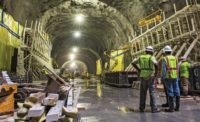“In terms of new projects, the amount of debt available is extremely limited,” Sacks says. “The assumptions that drove the previous market are gone.”

For banks, the lack of lending appetite has left “huge amounts of capital” unused, says Martinek at Northeast, an active lender in the region. He says banking regulators, particularly the federal chartering agencies, remain concerned that the commercial residential market is overbuilt and are “clamping down.” They are delving into loans already on the books, in some cases questioning appraisals from four years ago.
“They’ve pulled out their giant magnifying glasses,” Martinek says. “It’s not to say it’s unwarranted in some cases. But they had never gone that far back before to question the assumptions of a prior market for loans that were considered [sound] for the last two or three exams. That’s why bankers are in a mode of self-preservation.”
Longstanding real estate lenders – usually smaller regional banks – are trying to stay active but relying mostly on borrowers they know, says Tarter’s Pfeffer. The big international funds and national banks that fueled the construction boom in search of hot investments are all but gone, however.
Indeed, the commercial mortgage-backed securities world that funded many retail projects has dried up, says Laurier’s Terlizzi, who was previously a banker that served the Philadelphia and New Jersey markets. The concept allowed developers to parlay a new development’s anchor tenant – and the prospect of future lease signings – into a financing vehicle that could repay construction loans. But with leasing so weak, “that whole process is broken,” he adds.
Lenders, Terlizzi says, are also paralyzed because it’s difficult to gauge loan-to-value ratios while future income streams of properties remain fuzzy, or to set cap rates on loans while real estate trading is at a standstill.
The upshot is that lenders are asking for far higher levels of equity from retail developers than the 20% of recent years, to the point where putting up 40% equity is considered “lucky.” And interest rates are sky high, Terlizzi adds, saying a few percentage points “is enough to kill a project.”
Cayuga’s Sacks says he has seen banks that used to finance 75% of a residential project barely covering 40% now. “When you’re talking about a construction project with a two- to three-year investment period, it really changes your numbers,” he says.
The only attractive projects are those with highly secure revenue prospects, says Grassi’s Gavin. “No one wants the risk of a deal that can go bad,” he adds.
Northeast’s Martinek says his team is raking applications with a fine tooth comb, going well beyond the individual project specifications, and it is generally favoring smaller loans. “It doesn’t take many bad loans to take away all of your income,” he says.
Pfeffer says from the borrower perspective, due diligence by banks is much stricter, and Sacks echoes that the review process is at an “extreme” comparatively. Banks demand extra confidence today that loans will be repaid, they say.



